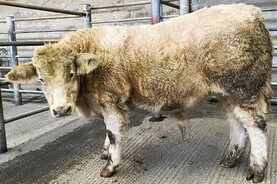Breeding season kicked off early for us, with the first animal inseminated on 2 January. A big framed heifer off Wilodge Cerberus, she won’t be calving at the ideal time of year for a first calver, but she certainly has the size to be fit for calving in nine months time.
Originally we thought she’d been covered by a strong Charolais bull weanling of our own but thankfully, as she’s a pedigree, she didn’t hold to him, though hopefully that was because of immaturity on his part rather than anything with her.
But what goes in must come out, with our first calf of the year arriving a couple of days later. As I predicted by his Salers/Belgian Blue/Limousin breeding, it was a lovely roan...bull.
By Negrita Du Lac (BB8019) he came quite large, with surprisingly strong bones, and he certainly didn’t want to make an easy entry into the world, requiring a calving jack and a bit of help to get him out.
A few days prior to the new calf arriving, we’d received a phone call from the Department of Agriculture to tell us we’d been selected for a spot check on our stock weights.Not had a full red blue here before. Every time I see him he looks bigger ???? pic.twitter.com/7hRkolhE2k
— Karen McCabe (@LadyHaywire) January 6, 2024
Whilst I understand these checks are necessary and a certain percentage of farmers are chosen at random each year, it’s not a great time of year to run cows that are heavily in-calf into a crush and stress them out.
Of course, that first cow decided to calve the evening before we had to weigh everything. Meaning we were stuck scratching our heads as to how we’d work around her taking up a pen which we’d planned to use for splitting stock which are prone to fighting.
Thankfully it all worked out with little hassle, and our main interest was in the three weanling weights who’ve been on roughly 2kg of ration each per day since being housed.
Our orphan calf was fostered by a cow on her own initiative, and she reared him alongside her own heifer. These ‘twins’ were 374kg and 345kg, which is average enough but good enough for a cow rearing two.
The biggest surprise was the youngest weanling born the last week of June, which came in at a whopping 335kg, or a daily gain of roughly 1.5kg a day.
The dam in question has no stars to speak of, but is one of the most docile animals on the farm and rears a good calf each year and that’s all one can ask for on a small suckler farm.
The original plan was to keep the bull weanlings until buyers were looking for cattle to put to grass, but with current weanling prices, dwindling bales in the yard and with our usual late turnout date being a few months away, the decision was made to show them in the local mart this week.
With everything in the shed genotyped, all we had to do for the new National Genotyping Programme was to order in the double sample tags for this year and a few button tags for the leftover numbers ordered last year.Debating selling these 2boys next Sat if there's no snow.
— Karen McCabe (@LadyHaywire) January 13, 2024
Originally we were keeping Nelson til summer but he's getting rather boisterous & with weanling prices as good as they are we'll take him along too ??
And Jimmy has decided rules are NOT for him so hes standing on dinner?? pic.twitter.com/GOHS9TcSCA
However, I’m not looking forward to working with not one, but two fiddly little tubes and a calf wriggling around like a snake beside me.
Numerous times that little clear tube has been dropped in the straw and a frantic search began before the calf or I stepped on it. Perhaps a neon pink option could be available for those of us who aren’t the best at finding the proverbial needle in a straw stack.






 This is a subscriber-only article
This is a subscriber-only article










SHARING OPTIONS: